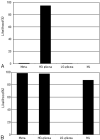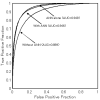Performance evaluation of radiologists with artificial neural network for differential diagnosis of intra-axial cerebral tumors on MR images
- PMID: 18388216
- PMCID: PMC8118852
- DOI: 10.3174/ajnr.A1037
Performance evaluation of radiologists with artificial neural network for differential diagnosis of intra-axial cerebral tumors on MR images
Abstract
Background and purpose: Previous studies have suggested that use of an artificial neural network (ANN) system is beneficial for radiological diagnosis. Our purposes in this study were to construct an ANN for the differential diagnosis of intra-axial cerebral tumors on MR images and to evaluate the effect of ANN outputs on radiologists' diagnostic performance.
Materials and methods: We collected MR images of 126 patients with intra-axial cerebral tumors (58 high-grade gliomas, 37 low-grade gliomas, 19 metastatic tumors, and 12 malignant lymphomas). We constructed a single 3-layer feed-forward ANN with a Levenberg-Marquardt algorithm. The ANN was designed to differentiate among 4 categories of tumors (high-grade gliomas, low-grade gliomas, metastases, and malignant lymphomas) with use of 2 clinical parameters and 13 radiologic findings in MR images. Subjective ratings for the 13 radiologic findings were provided independently by 2 attending radiologists. All 126 cases were used for training and testing of the ANN based on a leave-one-out-by-case method. In the observer test, MR images were viewed by 9 radiologists, first without and then with ANN outputs. Each radiologist's performance was evaluated through a receiver operating characteristic (ROC) analysis on a continuous rating scale.
Results: The averaged area under the ROC curve for ANN alone was 0.949. The diagnostic performance of the 9 radiologists increased from 0.899 to 0.946 (P < .001) when they used ANN outputs.
Conclusions: The ANN can provide useful output as a second opinion to improve radiologists' diagnostic performance in the differential diagnosis of intra-axial cerebral tumors seen on MR imaging.
Figures





Similar articles
-
Differentiation of common large sellar-suprasellar masses effect of artificial neural network on radiologists' diagnosis performance.Acad Radiol. 2009 Mar;16(3):313-20. doi: 10.1016/j.acra.2008.09.015. Acad Radiol. 2009. PMID: 19201360
-
Application of an artificial neural network to high-resolution CT: usefulness in differential diagnosis of diffuse lung disease.AJR Am J Roentgenol. 2004 Aug;183(2):297-305. doi: 10.2214/ajr.183.2.1830297. AJR Am J Roentgenol. 2004. PMID: 15269016
-
Usefulness of artificial neural network for differential diagnosis of hepatic masses on CT images.Acad Radiol. 2006 Aug;13(8):951-62. doi: 10.1016/j.acra.2006.04.009. Acad Radiol. 2006. PMID: 16843847
-
Computer-aided diagnosis of hepatic fibrosis: preliminary evaluation of MRI texture analysis using the finite difference method and an artificial neural network.AJR Am J Roentgenol. 2007 Jul;189(1):117-22. doi: 10.2214/AJR.07.2070. AJR Am J Roentgenol. 2007. PMID: 17579160
-
Magnetic resonance imaging protocols for paediatric neuroradiology.Pediatr Radiol. 2007 Aug;37(8):789-97. doi: 10.1007/s00247-007-0462-9. Epub 2007 May 9. Pediatr Radiol. 2007. PMID: 17487479 Free PMC article. Review.
Cited by
-
Machine learning for semi-automated classification of glioblastoma, brain metastasis and central nervous system lymphoma using magnetic resonance advanced imaging.Ann Transl Med. 2019 Jun;7(11):232. doi: 10.21037/atm.2018.08.05. Ann Transl Med. 2019. PMID: 31317002 Free PMC article.
-
Medical image analysis: computer-aided diagnosis of gastric cancer invasion on endoscopic images.Surg Endosc. 2012 May;26(5):1485-9. doi: 10.1007/s00464-011-2036-z. Epub 2011 Nov 15. Surg Endosc. 2012. PMID: 22083334
-
Evaluation of apparent diffusion coefficient thresholds for diagnosis of medulloblastoma using diffusion-weighted imaging.Neuroradiol J. 2014 Feb;27(1):63-74. doi: 10.15274/NRJ-2014-10007. Epub 2014 Feb 24. Neuroradiol J. 2014. PMID: 24571835 Free PMC article.
-
Systematic review of the performance evaluation of clinicians with or without the aid of machine learning clinical decision support system.Health Technol (Berl). 2023 Jun 13:1-14. doi: 10.1007/s12553-023-00763-1. Online ahead of print. Health Technol (Berl). 2023. PMID: 37363342 Free PMC article. Review.
-
Automated detection of multiple sclerosis candidate regions in MR images: false-positive removal with use of an ANN-controlled level-set method.Radiol Phys Technol. 2012 Jan;5(1):105-13. doi: 10.1007/s12194-011-0141-2. Epub 2011 Dec 3. Radiol Phys Technol. 2012. PMID: 22139608
References
-
- Abdolmaleki P, Mihara F, Masuda K, et al. Neural networks analysis of astrocytic gliomas from MRI appearances. Cancer Lett 1997;118:69–78 - PubMed
-
- Kobayashi T, Xu XW, MacMahon H, et al. Effect of a computer-aided diagnosis scheme on radiologists' performance in detection of lung nodules on radiographs. Radiology 1996;199:843–48 - PubMed
-
- Ashizawa K, MacMahon H, Ishida T, et al. Effect of an artificial neural network on radiologists' performance in the differential diagnosis of interstitial lung disease using chest radiographs. AJR Am J Roentgenol 1999;172:1311–15 - PubMed
-
- Nakamura K, Yoshida H, Engelmann R, et al. Computerized analysis of the likelihood of malignancy in solitary pulmonary nodules with use of artificial neural networks. Radiology 2000;214:823–30 - PubMed
-
- Matsuki Y, Nakamura K, Watanabe H, et al. Usefulness of an artificial neural network for differentiating benign from malignant pulmonary nodules on high-resolution CT: evaluation with receiver operating characteristic analysis. AJR Am J Roentgenol 2002;178:657–63 - PubMed
Publication types
MeSH terms
LinkOut - more resources
Full Text Sources
Medical
